Volterra, Wednesday of the week of Ferragosto, noon: the car thermometer reads thirty-five degrees, but the heat is dry, and ancient Velathri even today confirms its reputation as a windy city, reasoning that the heat can be endured very well. The same must be thought by the many tourists who, on this day of vacations and vacations, have chosen to arrive here to visit the city. And Volterra is not a place of passage, nor is it an extremely easy destination to get to: the nearest train station is in the hamlet of Saline, several kilometers downstream, and the superhighway goes all the way to Ponsacco, after which there is a forty-minute drive where at most it is sixty an hour. In Volterra, to make a long story short, you go because you want to go.
Of course, it’s not a normal summer, that of the Covid-19 pandemic: so many people are walking around wearing masks (even before the mayor orders their mandatory use even outdoors between 11 a.m. and 8 p.m., from Ferragosto until the end of the month: it seems the crowding is such that physical distancing is difficult), on the benches and at the tables of bars and restaurants people sit at a proper distance from each other, and even in the busiest streets of the historic center, those beaten at all hours by tourists of all backgrounds (via dei Marchesi, via Matteotti, via Gramsci, via Ricciarelli) people tend to scan their neighbors with certain care and lena. It is not a normal summer, but Volterra is trying to make it seem like one, and apparently succeeding, much better than elsewhere.
In this vacation week, venues are overflowing with patrons sitting at tables, in indoor halls and outdoor seating areas. At the Dogana parking lot, the one closest to the center, the only one underground (two euros per hour in exchange for the convenience of being a stone’s throw from Palazzo dei Priori and not having to leave the car to boil in the sun), to find a free spot you have to go down to the fourth floor, the last one. Scores of tourists wait patiently for their turn before entering the many shops selling souvenirs or alabaster objects: the entrance quota dictates this. Everyone knows this, and everyone stands in line without complaint. And there are also lines at all museums: at the Guarnacci Etruscan Museum, which houses one of the most valuable collections of Etruscan objects in the world, you struggle to keep your distance and sometimes have to wait a few minutes before entering a room. Couples, families, young and old alike enter the Pinacoteca Civica to admire the gold backgrounds, Rosso Fiorentino’s Deposition, Luca Signorelli’s extraordinary paintings, and the large seventeenth-century canvases from the Camaldolese Abbey of Montebradoni. Even, to enter the Palazzo dei Priori, which has been the seat of the Municipality since the thirteenth century and where tourists go to climb to the top of the Bell Tower to admire the view of the city and the landscape that surrounds it, one has to wait at least half an hour, we are informed by the attendant who, at the entrance, selects the visitors who can enter, making sure that the maximum number of people inside the Palace is scrupulously respected. Hard to glimpse groups, the perception is that it is a minute tourism, made up of small families, small groups of friends, couples of all ages. Attendances are many, however, and it seems that Volterra has not been affected by the coronavirus. On the contrary: it seems that a small miracle has occurred in the city, wanting to borrow a frumpy but effective term to understand what is happening in Volterra in the summer of the virus.
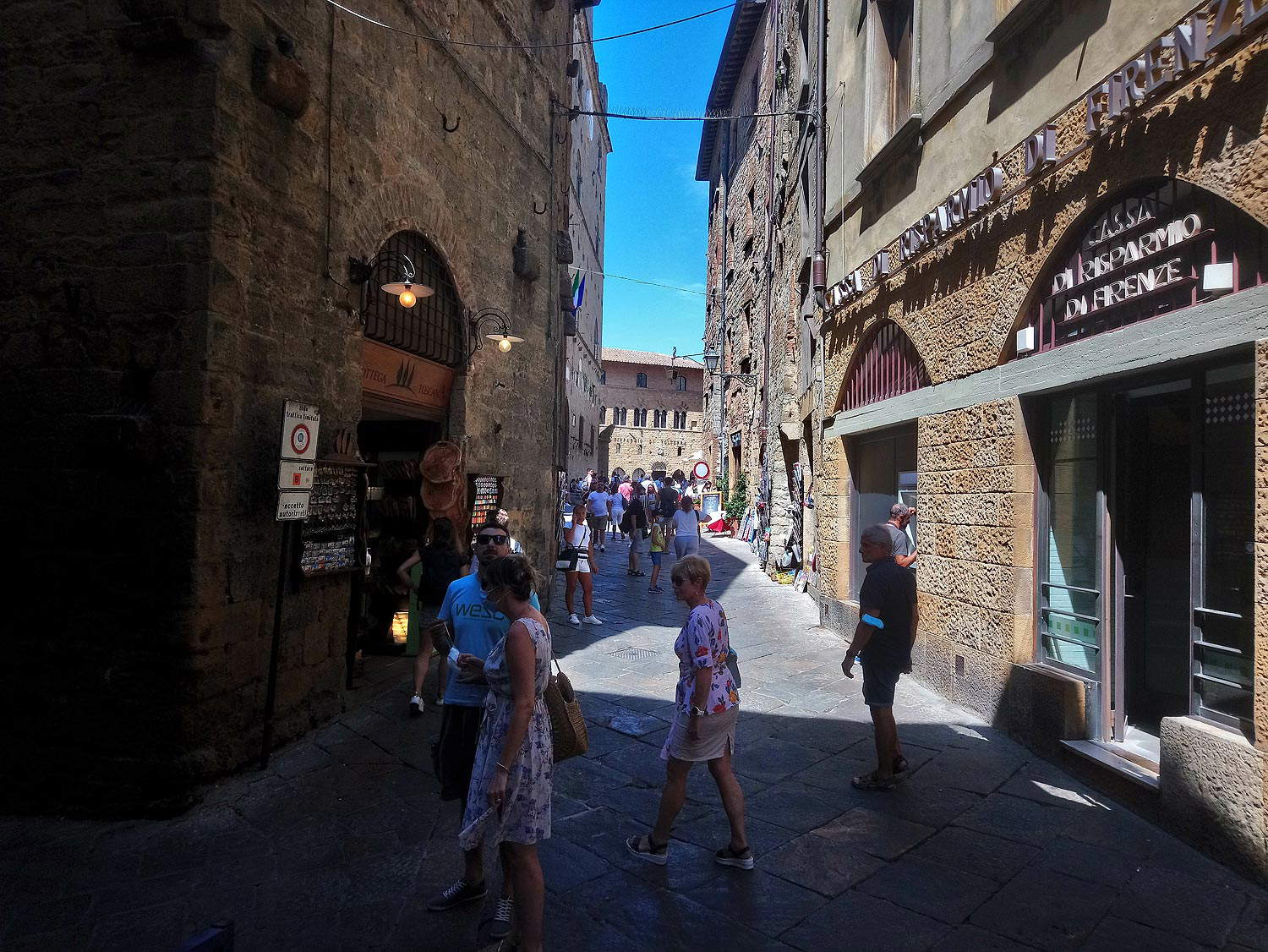 |
| Tourists in Volterra. Ph. Credit Finestre Sull’Arte |
 |
| Tourists in Volterra. Ph. Credit Finestre Sull’Arte |
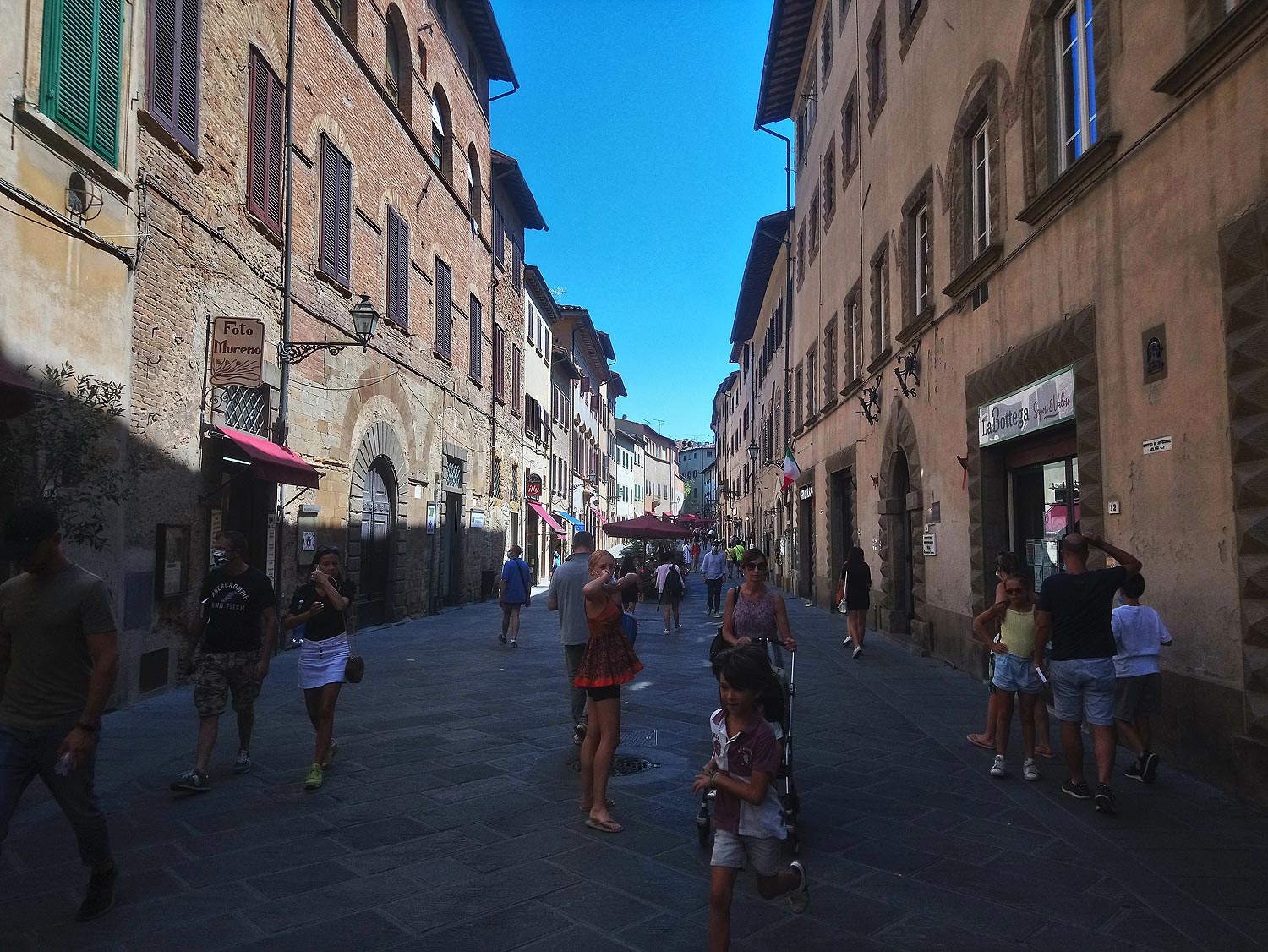 |
| Tourists in Volterra. Ph. Credit Finestre Sull’Arte |
The perception we have is confirmed by Claudia Bolognesi, director of the Volterra - Valdicecina Tourist Consortium. “The influx of guests in the week before Ferragosto and also in this one is truly incredible,” she tells us with some enthusiasm. “The historic center and the parking lots look like in the spring bridges of the pre-Covid era. Honestly, no one in April would have thought we would experience a tourist season of this magnitude. We are aware that this will not be enough to make up for what was lost between March and June, but it will certainly help the entire tourism industry in the area.” Complete figures for August are not yet available, but the Consortium is already talking about an exceptional month. There are, however, statistics for June and July provided by the Consortium: these are data collected empirically, based on tourists going to the Tourist Office (a new type of survey introduced this year), so they are necessarily incomplete and to be cross-referenced with the data that will come in from the accommodations, and which have not yet been published. But trends can still be gleaned: in June, the tourist bureau recorded 1,132 presences (89 percent Italian), while it recorded more than twice as many, or 2,279, in July, with the percentage of Italians standing at 72.18 percent and that of foreigners rising to 27.82 percent. Italians come largely from the north: they make up 81.28 percent. Tuscans, on the other hand, account for only 7.54%. As for foreigners, half come from France and Germany, followed, in much lower percentages, however, by Belgium, Holland and Switzerland. And we are talking about tourists who, in 90 percent of cases, sleep nearby. Most (23% in June, 30% in July) are tourists who stay overnight along the Tyrrhenian coast and choose Volterra as a destination for a day trip away from the beaches (a typical characteristic of Volterra tourism). So many, however (in percentages close to 15 percent) sleep in the city or in the immediate surroundings, and it exceeds 30 percent, both in June and July, if overnight stays in the provinces of Pisa and Siena are also taken into account.
And August is going to be even better: in the city and its immediate environs there is a sell-out until the 24th of the month. This is what the local authorities say, but it can be easily verified by looking for a room, even if only for one night, for this weekend: it is difficult to find a vacant facility. Complete data are still lacking, but it can already be said that tourism in Volterra has held up this summer and has not suffered from the Covid-19 setbacks, as happened in the major art cities. In Florence, for example, the Italian National Tourist Agency estimates a drop in attendance of around 60 percent this summer: sure, the capital is a big city and therefore, in terms of absolute numbers, the higher they are, the harder they are to recover, but in Volterra’s favor it can be said that there are also smaller localities that are trudging along (this is the case in the villages of Umbria, where it is only Orvieto that seems to be limiting the damage better than in 2019).
What is the secret of Volterra’s success? Claudia Bolognesi points to three, related to the work done during the months of confinement. The first point is the work done on the web: “following the advice that came to us from the digital labs of Toscana Promozione Turistica and Fondazione Sistema Toscana,” says the director, “we worked constantly on social media and the portal.” And again, “we created a Facebook group aimed at local tour operators and experts in the field who populated it with interesting and current content. Above all, this initiative has served to keep the attention of local businesses operating in tourism, which, in this way, have never felt alone and have been thinking about the reopening from the very beginning.” Third, the preparation of “two questionnaires (one for receptivity and one for catering)” that resulted in a survey from which “it emerged that most of the businesses intended to reopen as soon as possible and to maintain staffing levels.”
But that’s not all: since the May 18 reopening, everyone (hoteliers, restaurateurs, merchants, local authorities) has been working to ensure that, as the summer tourist season resumes, visitors can find something to visit, as well as essential services that can be enjoyed. The Consortium then continued its digital marketing strategy by implementing targeted social media campaigns that included thematic videos and landing pages on the Consortium’s portal. “The campaign,” confirms Bolognesi, “has been and is having incredible success in terms of contacts and requests coming to our offices. An exceptional result, again far exceeding expectations.”
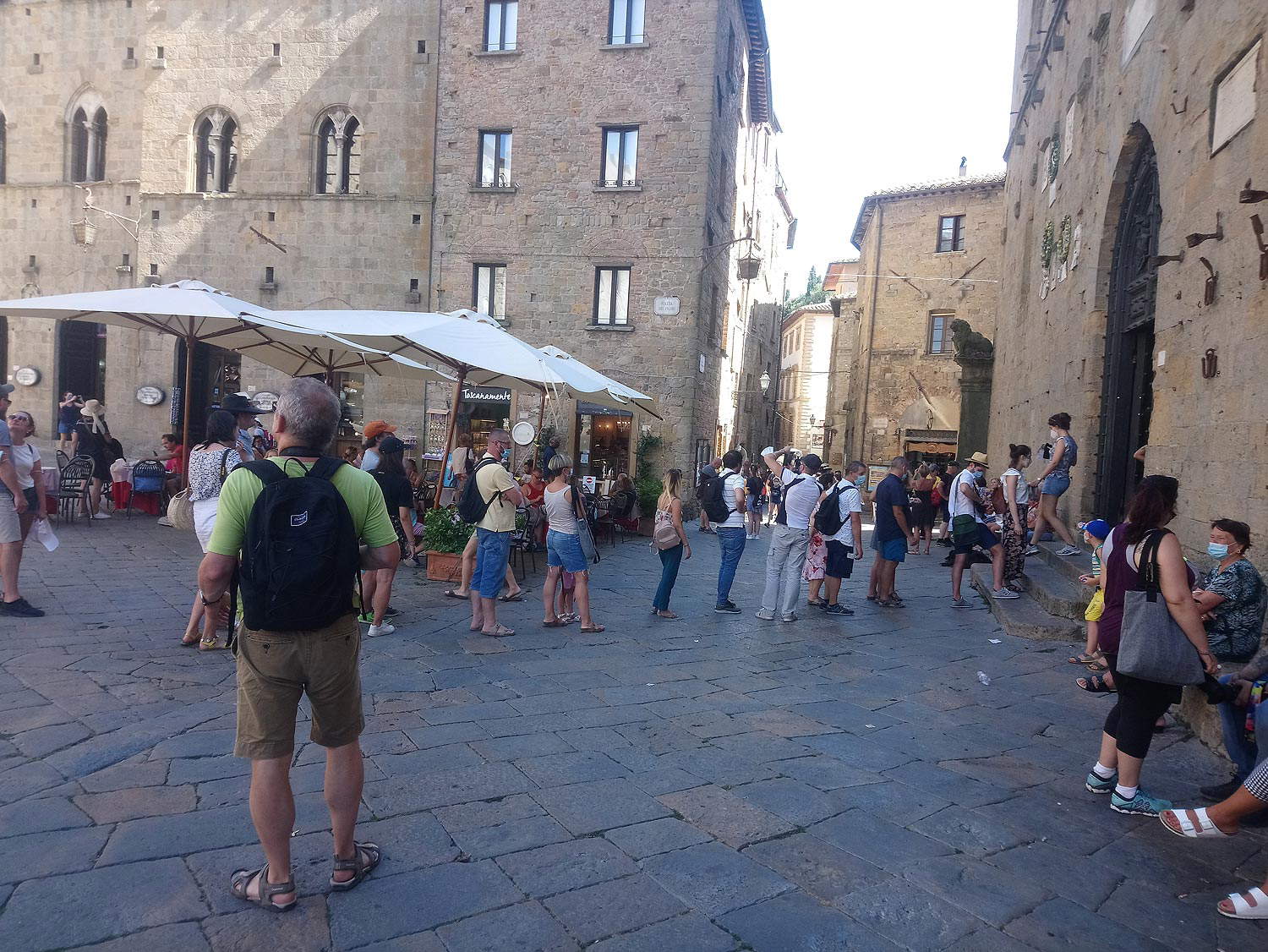 |
| The queue to enter Palazzo dei Priori. Ph. Credit Finestre Sull’Arte |
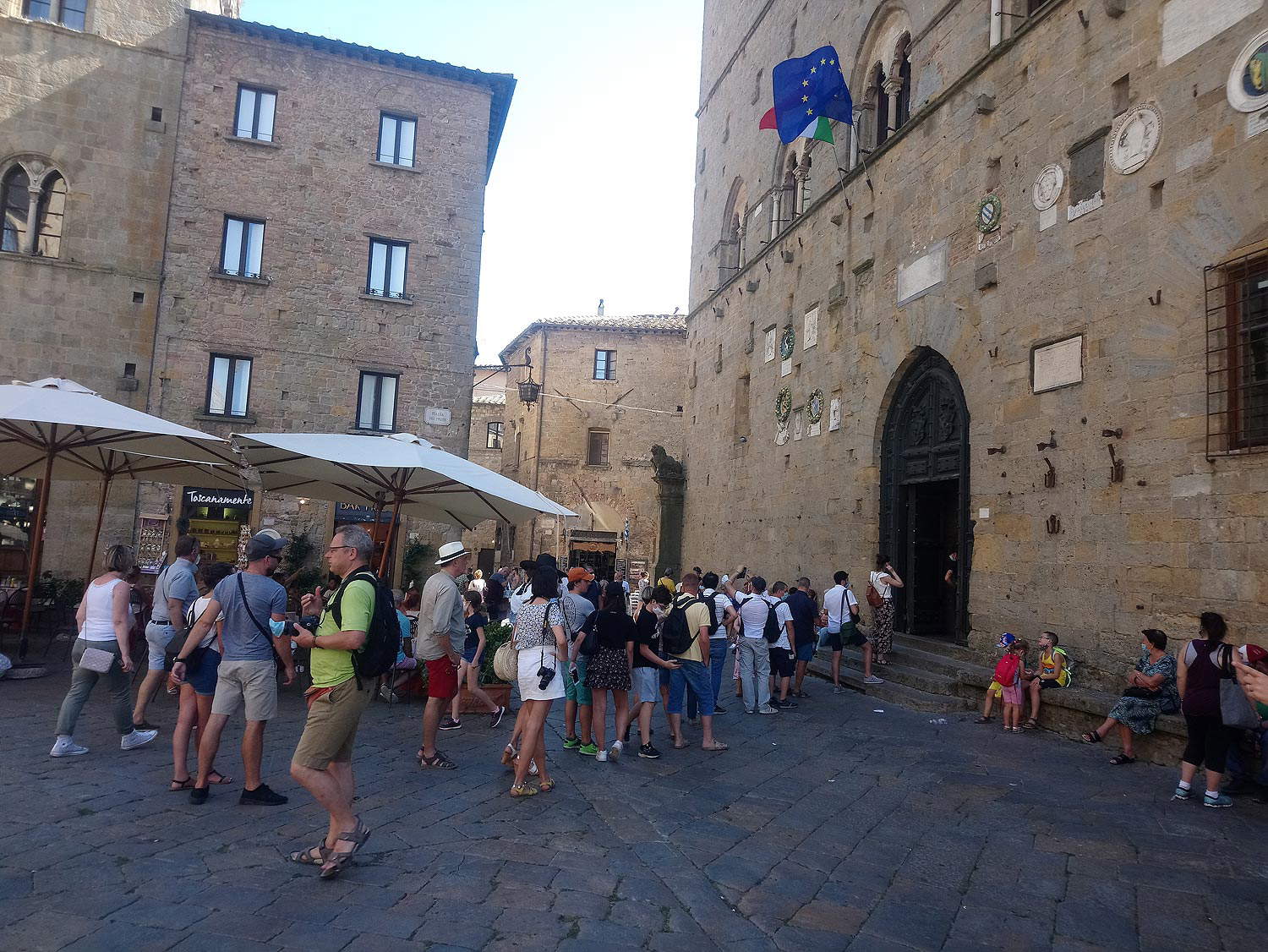 |
| The queue to enter Palazzo dei Priori. Ph. Credit Finestre Sull’Arte |
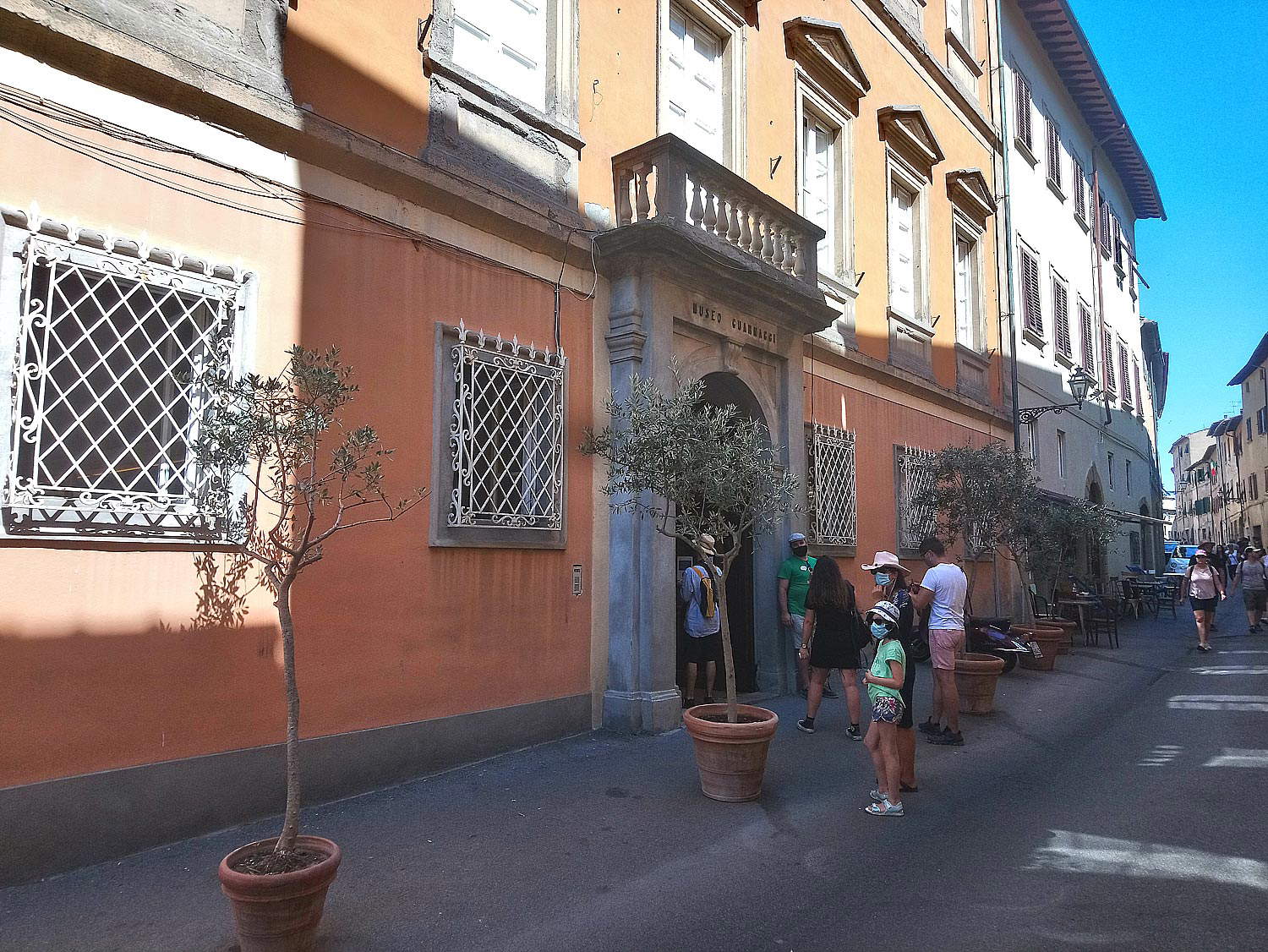 |
| The queue to enter the Guarnacci Museum. Ph. Credit Finestre Sull’Arte |
While data on tourist arrivals and attendance are still being processed, data on the influx to the city’s museums are already available: they are an important indicator for understanding how the tourist season is going, but not only that. The Consortium has noted two very interesting trends: first, is the increase in the number of young people (couples and small groups of friends, consisting of four or five people) who have chosen Volterra as their vacation destination. The second, is the much greater interest than in the past in museums, art and culture. And the numbers confirm this: comparing on opening days alone, as many as 68 people visited Volterra’s museums (the Guarnacci Etruscan Museum, the Pinacoteca Civica, the Etruscan Acropolis, the Roman Theater and the Palazzo dei Priori) in 2020.308 visitors, down 6.91 percent from 2019, when there had been 73,380 visitors: such a low drop in such a dramatic year must be read as a great success (just think of the fact that this year’s tourist groups are not to be seen, having practically dropped to zero). There are two museums where even visitor numbers are higher than in 2019: this is the case of the Pinacoteca Civica (10,248 visitors in 2020 versus 9,540 in 2019, an increase of 7.42 percent) and the Etruscan Acropolis (13,001 visitors versus 11,630 in 2019, an increase of 11.79 percent). Cash receipts also held up: again counting on opening days only, Volterra’s museums grossed 216,198 euros, down 11.46 percent from 244,182 euros in 2019.
Again, the work done during the so-called lockdown paid off. That’s what Alessandro Furiesi, director of Volterra’s Pinacoteca Civica, thinks: “choices were made,” he tells Finestre Sull’Arte, “which have now brought results: the first was to get employees to work on making the museums more welcoming, with minor maintenance work (painting walls, furniture and display cases, thorough cleaning, small changes to the reception area and the layout), some training for operators, a review of theinventory and the deposits. Visitors thus found themselves faced with renovated and welcoming museums, new works and objects brought into the exhibition halls from storage, and a staff more motivated and ready for their needs. The second was to keep our social channels active, in the same way as before, without organizing online initiatives or virtual visits. We focused, as always, on telling in a simple way about our works, a choice greatly appreciated by our followers who have increased to over 4000 on Facebook and 800 on Instagram. Interesting result, since we do not have professional social media managers working there.”
Moreover, in contrast to what happened in other places (where museums are still closed), in Volterra we took steps to reopen everything as soon as possible: the archaeological areas returned to welcome visitors on May 29, while for the museums it was necessary to wait until June 12, but when reopening, the same hours and access arrangements in force previously were maintained (of course, with all the necessary medical and health precautions, on which the staff carefully supervises: and we reiterate that getting infected at the museum is practically impossible, since in all museums regulations are followed very scrupulously), and information material has been prepared to ensure that everyone can visit in complete safety. What’s more, in order to boost visits, some promotional offers designed even before the confinement have been reactivated: the first is the reduction on the ticket for all Tuscan citizens, in order to promote proximity tourism. The second is the discount for tourists who stay in the city and decide to book the museum ticket through the hotel where they stay. Above all, this choice has proved decisive: “The collaboration with hotels,” Furiesi points out, “has been effective both in increasing ticket sales and in promoting the museums; in just a few months we have reached a level of collaboration with tour operators that we had never seen before. The interesting thing for insiders is that we manage the coffers in economy, we don’t have managing entity, which for a municipality makes it very difficult to apply these tools: with Covid-19 we have managed to accelerate this path that many public entities can’t even begin.”
Volterra’s museums have also decided not to cancel guided tours, on the contrary: they have been enhanced (given also the surge in demand) according to a dual directive (intensification and improvement of the service), with the result that they are very well attended, and visitors are satisfied. The only negative note is the cancellation of events: the only museum that would have adequate space is the Pinacoteca, but at least for this summer it will have to do without it because the Municipality of Volterra has cut investment in culture to meet expenses due to the health emergency. The initiatives that the Pinacoteca will host in the future will therefore be carried out in collaboration with associations and other private entities. There will, however, be an exhibition, dedicated toalabaster, which will begin in September, on the premises of Palazzo dei Priori.
Finally, Alessandro Furiesi would like to emphasize an important element, which in his opinion is decisive for the results of the Volterra museums: “we made everyone go back to work, both the employees of the municipality and those of the cooperatives. A choice that was strongly suffered (before), but wanted both by me and by the municipal administration (both colleagues from other sectors and politicians), and a choice that was not easy and that in many other realities was not shared, but that has certainly brought results also from the point of view of cohesion and working well-being in our museums (we are talking about almost 40 people between temporary and seasonal employees).”
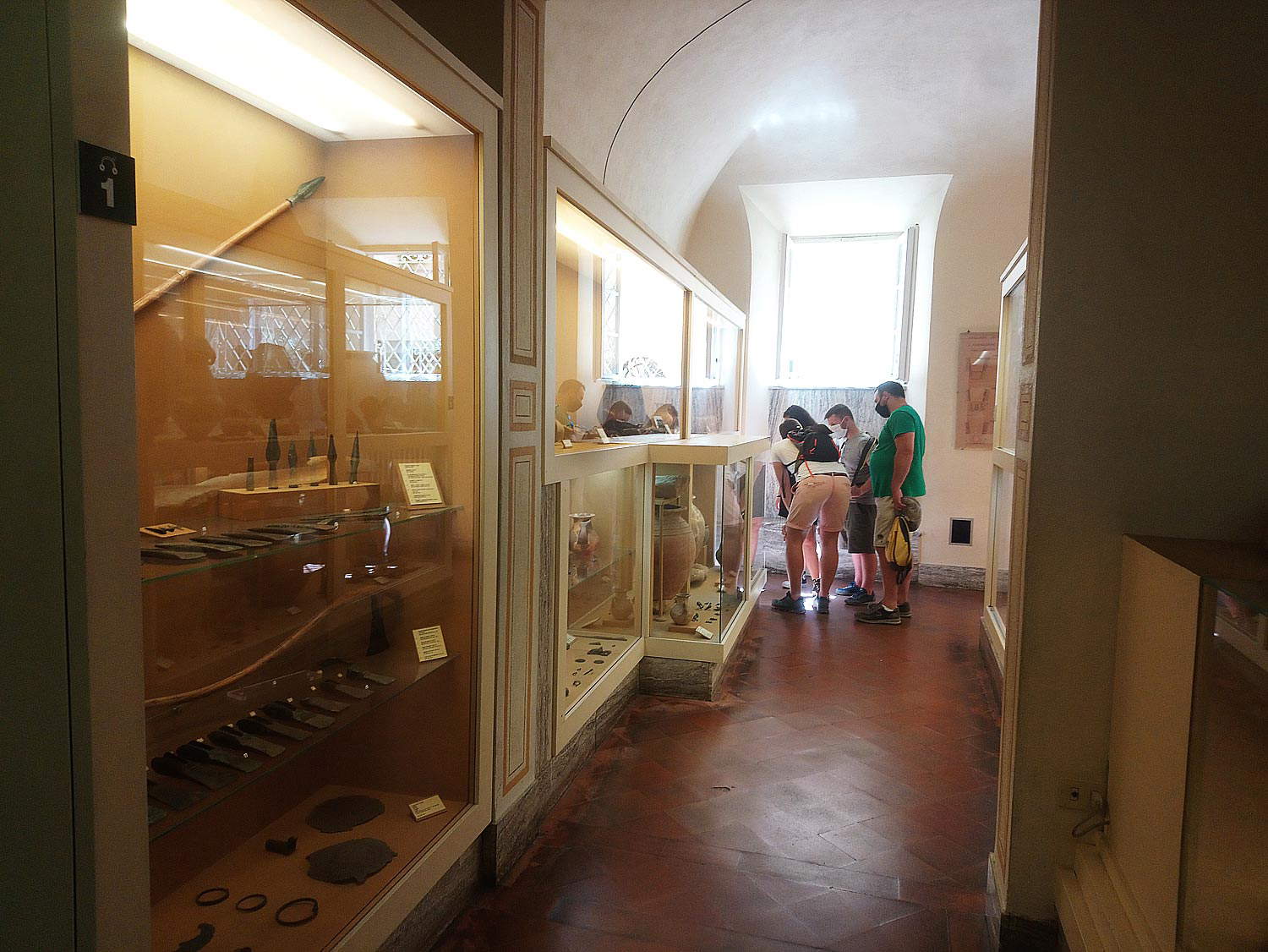 |
| Visitors in the halls of the Guarnacci Museum. Ph. Credit Finestre Sull’Arte |
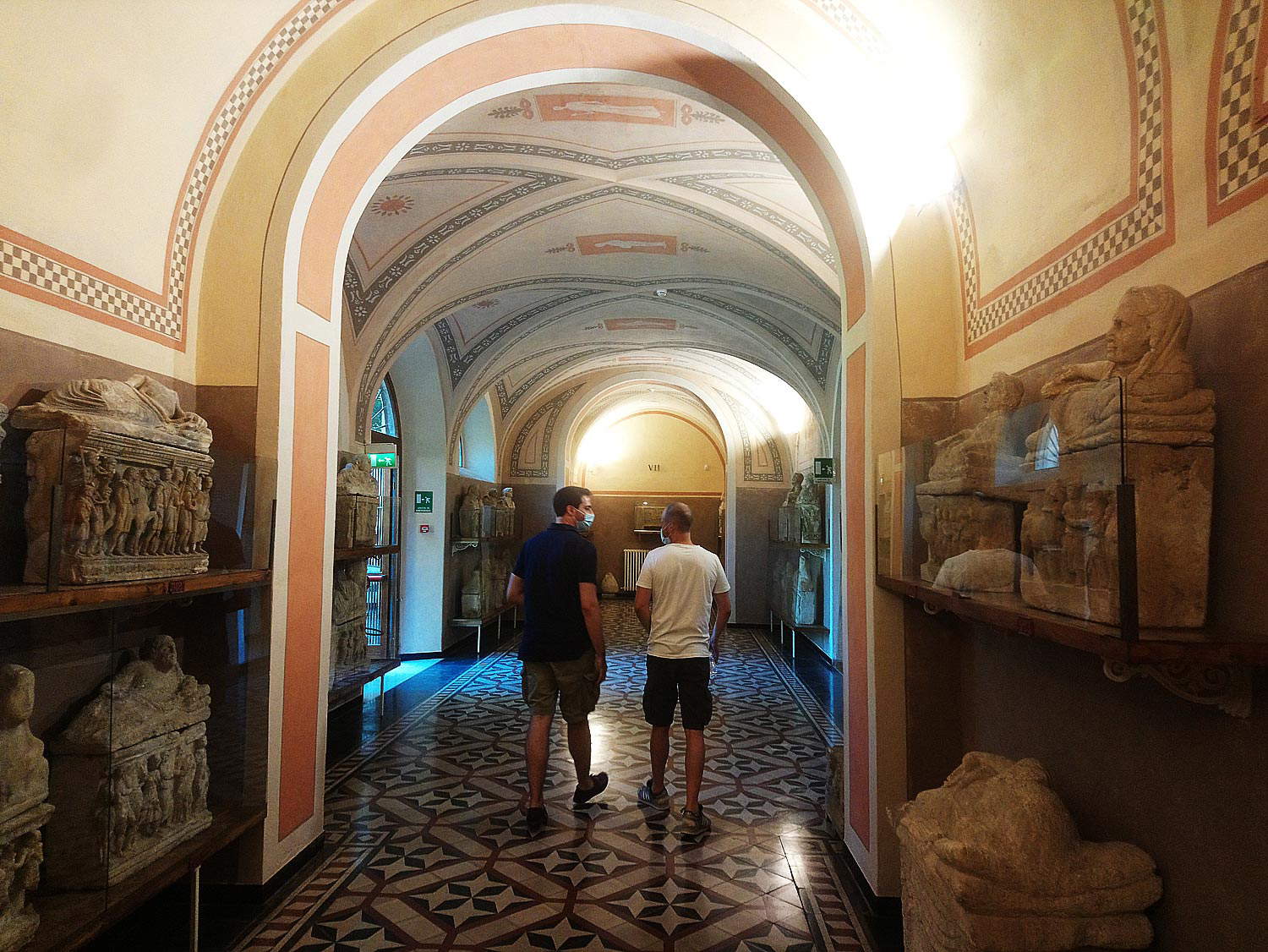 |
| Visitors in the halls of the Guarnacci Museum. Ph. Credit Finestre Sull’Arte |
 |
| Visitors in the halls of the Guarnacci Museum. Ph. Credit Finestre Sull’Arte |
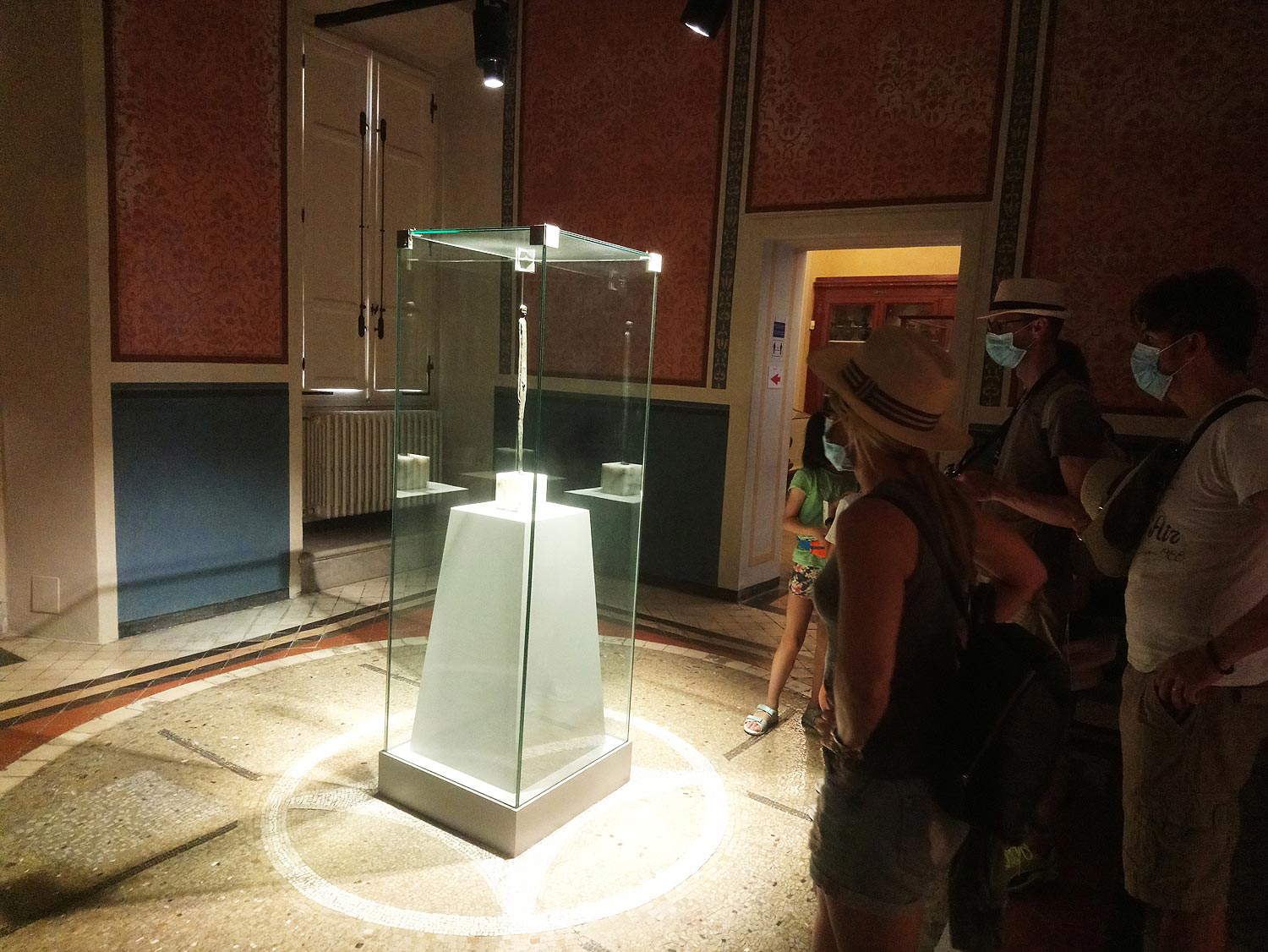 |
| Visitors observe the Evening Shadow at the Guarnacci Museum. Ph. Credit Finestre Sull’Arte |
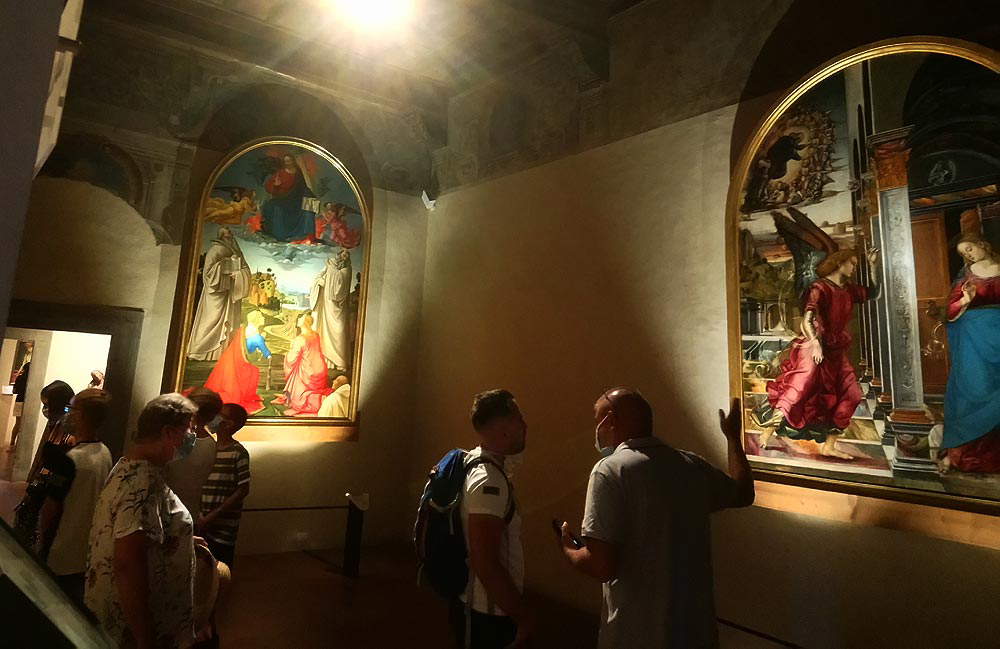 |
| Visitors in front of Luca Signorelli’s Annunciation at the Volterra Art Gallery. Ph. Credit Finestre Sull’Arte |
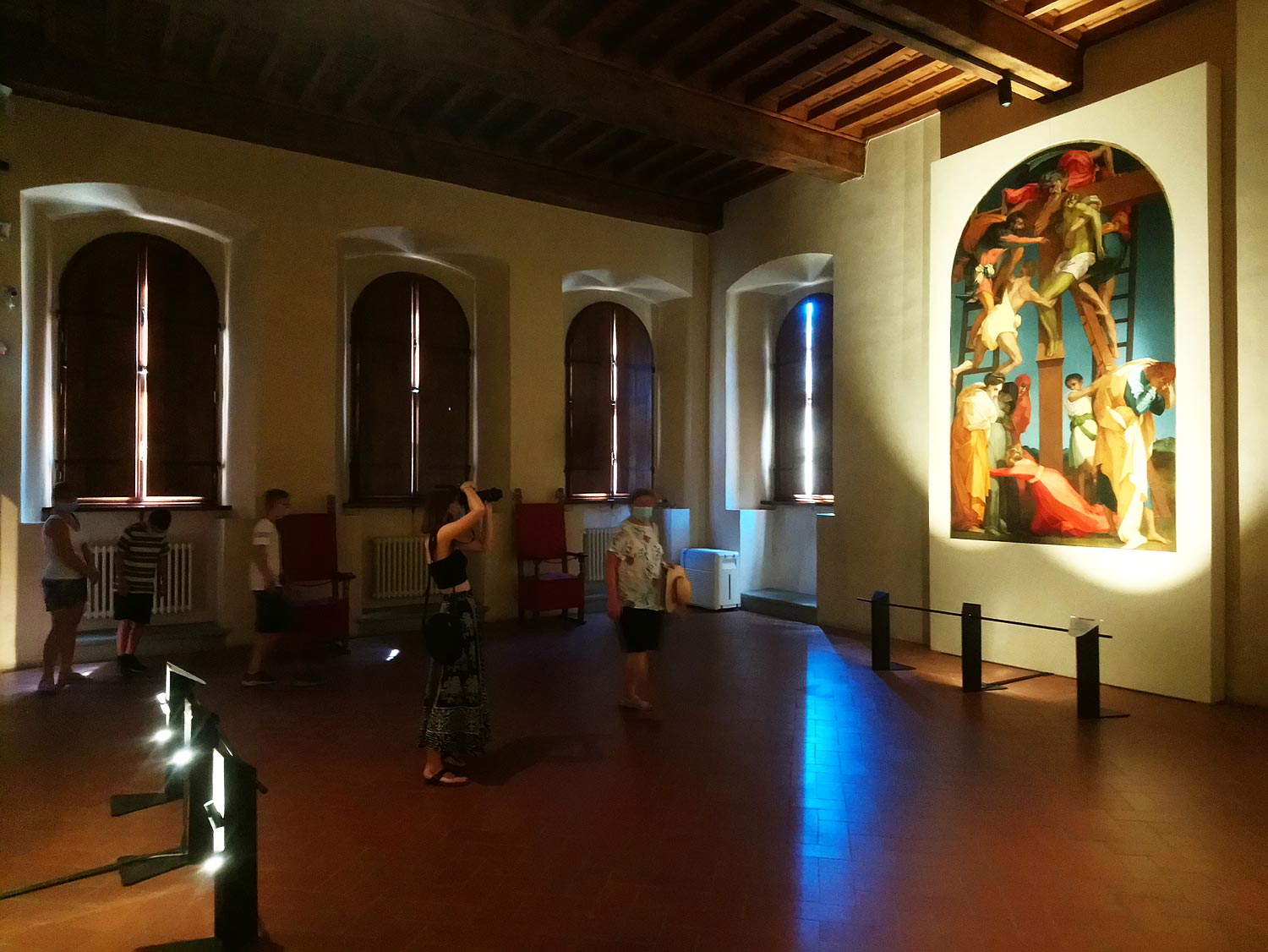 |
| Visitors in front of Rosso Fiorentino’s Deposition at the Volterra Art Gallery. Ph. Credit Finestre Sull’Arte |
What indications can be drawn from the Volterra example? Obviously, it is not possible to expect to return to last years’ numbers, but the Tuscan city demonstrates that tourism can exist even during the pandemic, and that it may even provide some basis for future, more sustainable tourism when the virus is a thing of the past. In the meantime, the feeling is that tourists are more aware: “this year’s visitor,” says Alessandro Furiesi thinking of those who are frequenting the museums in these weeks, “is a different tourist than in recent years: they are more informed, attentive, they ask to know what they are seeing, they look for information about the place, and, above all, they stay longer. This long stay allows them to see everything about the city; in fact, card sales have increased tremendously, as has the performance of the bookshops.” If the idea, for the months and years to come, is to limit the massified and voracious tourism and instead promote a more attentive tourism, the recipe that comes from the villages of Tuscany could be very interesting: consider then that the summer of 2020 has also recorded a surprising “redemption” of small museums, since the increases that Volterra is experiencing are a widespread situation in much of Tuscany (the museums of the Val di Cornia, for example, have marked a +25% compared to 2019). It is proof that the area’s museums, wrongly considered minor and therefore often forgotten, represent not only indispensable landmarks for their communities, but also strategic elements of great relevance for attracting tourism.
Moreover, Volterra’s success is also due to targeted advertising campaigns, which do not disdain social media, which are able to segment audiences well (Volterra’s idea is to communicate its specificities, rather than the destination as a whole: we therefore address in different ways and with different channels those who love contemporary art and those who prefer ancient art, those who are interested in the city’s Etruscan past, those who are instead passionate about crafts, those who are passionate about food and wine, and those who are passionate about green, outdoor and sustainability), and that consequently were able to hit the mark. Volterra this year is then benefited by its candidacy as Italian Capital of Culture for 2022: and additional ad hoc campaigns have been created for this candidacy. “An important and far-reaching operation,” says Claudia Bolognesi, “which has brought enormous visibility to both Volterra and Valdicecina. There have been numerous and valuable television reports and articles published both before February and from May onward. And we hope that this project will start a virtuous path that will allow the enormous historical, artistic and naturalistic heritage that characterizes Volterra and the Valdicecina to come to fruition.”
Lastly, the subject of collaboration with neighboring cities, a topic that is often talked about these days, also in view of a possible exhibition that could start soon and that should display, together, theShadow of the Evening from the Etruscan Museum of Volterra and the Hinthial statuette from San Gimignano made known to the public for the first time last fall. This could be the beginning of a common strategy of the two districts, that of Volterra and that of neighboring San Gimignano, to create a single tourism “circuit.” The road of tourism of the future, in short, will probably pass through the villages of Tuscany.
Warning: the translation into English of the original Italian article was created using automatic tools. We undertake to review all articles, but we do not guarantee the total absence of inaccuracies in the translation due to the program. You can find the original by clicking on the ITA button. If you find any mistake,please contact us.